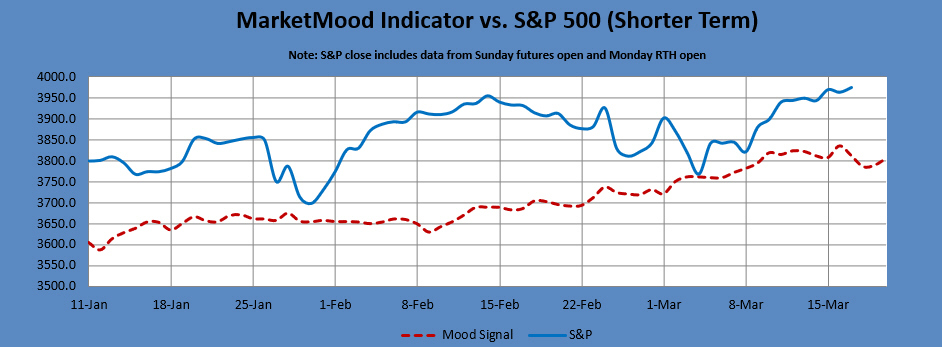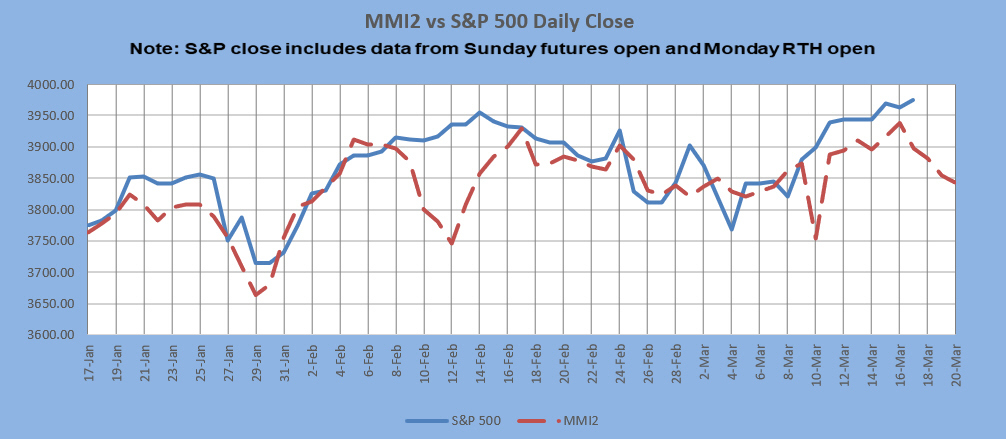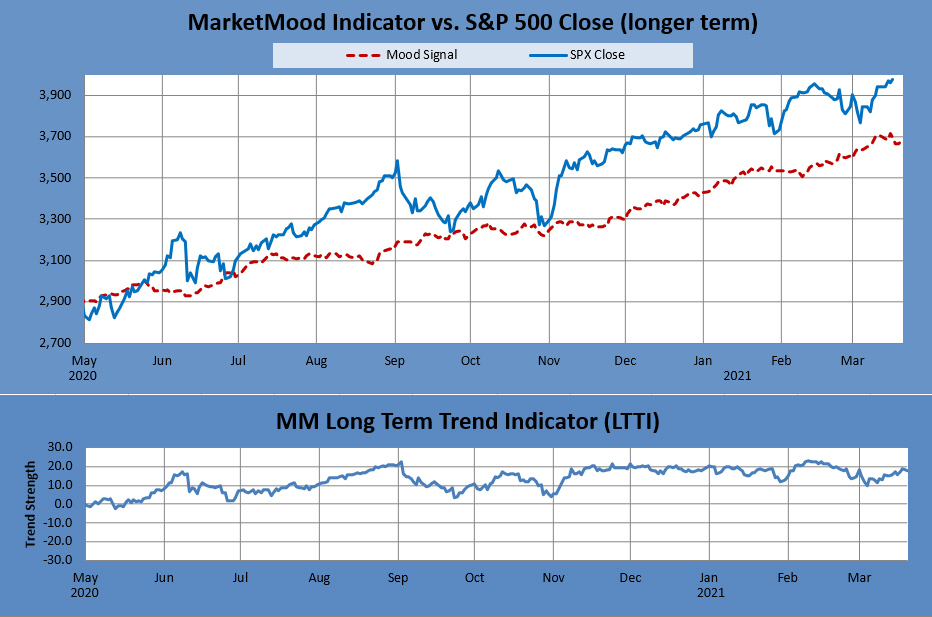MarketMood Thursday: The Morning After
Where We've Been:
Today's mood pattern implied "building tension" which was appropriate on a Fed day. MMI was down today and the market was moderately down until... the FOMC announcement at which time it regained losses and closed higher for the day. Today's close confirmed our major high signal. Now we watch for the market to tell us we have made a top of some kind as our secondary window goes through the 24th.
Where We're Heading:
Thursday's mood pattern tends to be bearish, although there may be a surprise thrown in the mix (in either direction) on Thursday / Friday. MMI is calculated as down for Thursday and is a flip from down to up day for Friday (ideally, down first, ambiguous, then turning up).
There is a confirmed MAM major high signal in place. The primary window for this high is March 10-March 17. There is a slightly less probable secondary window for this high for March 17-24. This signal results from both mood and market being sufficiently bullish that a major high is now considered imminent. Currently, there has been no support broken and no confirmation that a high was actually made today. Only the market can confirm that a pullback has begun.
Internet search theme source data for MMI inputs (mood vs. effect inverted): TV, music, awards, men, sports, school, schedule, championship, entertainment, choices
Next 3 Days:
| Date | Daily MMI | MMI 2* |
| 3/18 | down | down |
| 3/19 | flip up | - |
| 3/22 (open) |
*MMI 2 uses an alternate dynamic algorithm to convert the same sentiment source data to S&P direction as the original MMI algorithm.
MM Indicators and Trading Parameters Summary:
| Indicator | Scope | Direction |
| LTTI | Longer Term Trend | Bullish |
| MMTT (main) | Medium Term Trend | Bullish |
| MMTT (HP) | Medium Term Trend | Bullish |
| MMTT (b/b) | Near Term bull/bear Trend Line | 3947 SPX |
| MM MACD | Swing Trade | None |
| MMI | Next calculated daily sentiment bias | down |
Note: Medium term is roughly 1 week to 2 months. Longer term is roughly 1 month to 1 year.
Shorter Term MarketMood Indicator vs. S&P 500 Charts:
The Moving Average Momentum (MAM): It's been quite a long time since there was a normal major high or low signal. the indicator's last major low signal was 24-31 Dec., 2018. The market rallied strongly following the close on Dec. 24 which fulfilled the major low signal. There was an ambiguous low signal from 20-27 Mar. 2020. It was a combo major low and minor high in the same region. The market did make a substantial low in that time-frame. The last major high signal was 8-27 Jan. 2020 (possibly the longest window ever). The closing high in that window was 3330 on the 17th then again 3326 on the 23rd. The S&P 500 dropped about 100 points from there through end of month, which was the largest drop in some time. The market then rallied through February 19th to 3386, 60 points above the last high. That was the actual high point, about 3 weeks past this 3 week window. It most definitely was a major high point as it was followed by a steep drop of almost 1000 points before a closing low on March 23, 2020.
There is a confirmed MAM major high signal in place. The primary window for this high is March 10-March 17. There is a slightly less probable secondary window for this high for March 17-24. This signal results from both mood and market being sufficiently bullish that a major high is now considered imminent. Currently, there has been no support broken and no confirmation that a high has actually been made. Only the market can confirm that a pullback has begun.
Current status: neutral
Intermediate Term Forecast:
There are two primary scenarios for April-May depending on how March finishes up. The base case is for the current decline to bottom and then for a continuation up to a high in March. The alt case would be for a failed rally down to a low in March. The weekly outlook shows a stimulus induced bullish tilt for approximately March 17-22. Other than that it's ambiguous in the near term.
MM MACD signal is SELL and the intermediate trend is bullish > 3842. There is no swing trade signal.
The MM MACD is similar to a standard MACD, except that it uses the MMI signal data to extend several days beyond today, while the standard MACD relies solely on historical market data.
Long Term Forecast:
The long term trend is indicated by the general divergence between the stock market and the mood generated forecast (see long term chart below). The MM Long Term Trend Indicator (bottom chart) which is derived from this divergence, indicates: "Bullish Trend, hold long long-term positions." The MM LTTI has had this indication since 4 Nov 2020.
The MM LTTI measures trend strength using the divergence between the market trend and the forecast trend.
Limitations:
MMI does least well in these conditions-- 1) EW 4th wave, 2) EW b wave, 3) Diagonals, and 4) Topping. More than one of these conditions concurrently present will further diminish performance.






